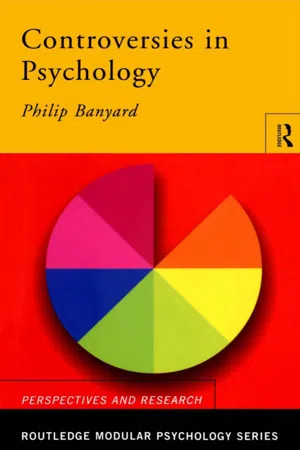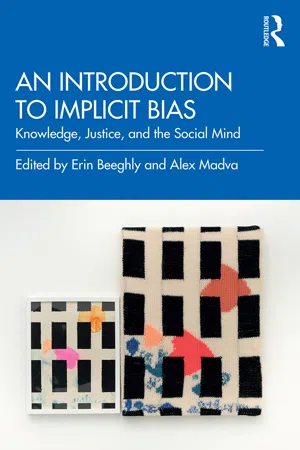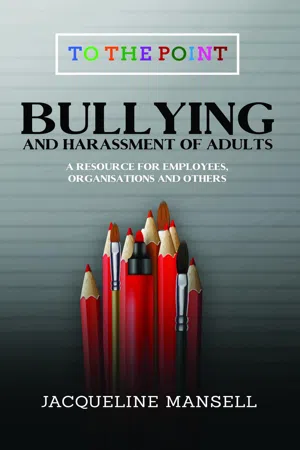Bias
Bias refers to the tendency to favor one thing, person, or group over another, often without rational justification. In psychology, bias can manifest in various forms, such as cognitive biases that influence decision-making and social biases that impact perceptions of individuals or groups. Understanding bias is crucial for recognizing and addressing its influence on behavior and attitudes.
5 Key excerpts on "Bias"
- eBook - ePub
- (Author)
- 2020(Publication Date)
- Wiley(Publisher)
...As hinted above, there has been a long history in which psychological research discriminated against women, ethnic minorities (Gould, 1996) and people with certain sexual orientations (Herek, Kimmel, Amaro, & Melton, 1991). Just as anybody else, psychologists are influenced by dominant ideologies about health, morality, gender, politics, etc., and when caught off guard, psychologists can reproduce these ideologies in their research findings. It should be noted, though, that conducting objective research does not necessarily require psychologists to give up their stances, which is unrealistic. Instead, it requires psychologists to be aware of their stances and prevent them from unconsciously Biasing research. Biases can hide in popularly shared research assumptions. For instance, classical psychoanalysis has been criticized for its overemphasis on the irrational aspects of human mind, behaviorism for its neglect of consciousness, neuropsychology for locating the cause of human behavior in the brain while ignoring social context. Researchers tend to treat their core research assumptions for granted, but a comparison among various schools suggests that their theoretical assumptions are prone to Bias. Biases can be caused by the academic structure in which researchers work. For instance, the “weird” population problem discussed above occurs because most psychologists conduct research in Western universities and have the easiest access to the “weird” population. In other situations Biases stem from disciplinary or academic culture or convention. For example, journals tend to publish positive experimental findings – findings that are statistically significant and support the initial hypothesis. This Bias is also called file drawer effect, because findings that do not support the hypothesis are less welcomed by publishers and often end up in researchers’ filing cabinets...
- eBook - ePub
- Phil Banyard(Author)
- 2003(Publication Date)
- Routledge(Publisher)
...4 Bias in psychology Introduction It is interesting that we have a title such as ‘Bias in psychology’. It seems obvious to me that everything in psychology contains some sort of Bias or other, but what is remarkable is that this Bias is often not acknowledged. Perhaps this is because one feature of the scientific approach in psychology is the attempt to be objective. To be objective is usually taken to mean standing apart from the subject that is being studied, and being free from Bias. This might be possible if we are studying chemicals or micro-organisms, but is it possible to be objective when we are studying the behaviour and experience of people? It is difficult, if not impossible, to stand apart from the subject that is being studied when the subject is human behaviour and experience and you are a human being. In this chapter we will look at some examples of Bias in psychology, and pay particular attention to issues around cultural diversity and gender. We will start by looking at the concept of ethnocentrism. Ethnocentrism One source of Bias in psychology comes from the fact that we tend to see things from our own viewpoint and the viewpoint of people like us. In our everyday lives we are asked to make judgments about people and events. We have a range of opinions that we are prepared to offer to other people when asked, and sometimes when not asked. In our judgments we are often inclined to show a little egocentrism (seeing things from our own particular viewpoint to the exclusion of others)...
- eBook - ePub
An Introduction to Implicit Bias
Knowledge, Justice, and the Social Mind
- Erin Beeghly, Alex Madva, Erin Beeghly, Alex Madva(Authors)
- 2020(Publication Date)
- Routledge(Publisher)
...One of the great criticisms of behaviorism, however, is that it cannot account for mental interaction, that is, effects that are the joint result of many mental causes. So, try to think about implicit Bias in the context of a complete psychology that has perceptions, inferences, actions, desires, problem-solving abilities, is embodied, etc. (see Leboeuf, Chapter 2, “The Embodied Biased Mind,” and Greene, Chapter 7, “Stereotype Threat, Identity, and the Disruption of Habit”). How might our understanding of implicit Bias and its construct change when we think about it in this domain? Psychologists Amos Tversky and Daniel Kahneman are famous for work demonstrating that the human mind is prone to adopt a wide-variety of shortcuts and heuristics (see Beeghly, Chapter 4, “Bias and Knowledge: Two Metaphors” for more on the view of Biases as “shortcuts”). They argue that the mind is composed of two distinct “systems”: system one involves the many mental shortcuts and is responsible for our fast, automatic behaviors while system two involves more rational processes and is responsible for our slow, deliberate behaviors. How does this picture fit with the theories of implicit Biases that we’ve been discussing? What implications might this have for the existence of other implicit constructs outside of the social domain? How might this change the way we theorize about the psychology of Bias? REFERENCES Axt, J.R., Ebersole, C.R., and Nosek B.A. (2014) The rules of implicit evaluation by race, religion, and age. Psychological Science, 25(9): 1804–1815. Banaji, M.R. and Greenwald, A.G. (2013) Blindspot: Hidden Biases of Good People. New York: Delacorte Press. Banaji, M.R. and Hardin, C.D. (1996) Automatic stereotyping. Psychological Science, 7(3):136–141. Bar-Anan, Y., Nosek, B.A., and Vianello, M. (2009) The Sorting Paired Features Task: A measure of association strengths. Experimental Psychology, 56(5): 329–343. Brinol, P., Petty, R., and McCaslin, M...
- eBook - ePub
Taking Sides in Social Research
Essays on Partisanship and Bias
- Martyn Hammersley(Author)
- 2005(Publication Date)
- Routledge(Publisher)
...The effect of this is evident, for instance, in the claim that ‘the question is not whether the data are Biased; the question is whose interests are served by the Bias’ (Gitlin et al. 1989:245). Here, the recommendation is that research should be Biased: in favour of serving one group rather than another. Of course, this is not the predominant sense of the term ‘Bias’ as it is used in the social sciences. Instead, Bias is generally seen as a negative feature, as something that can and should be avoided. Often, the term refers to any systematic deviation from validity, or to some deformation of research practice that produces such deviation. Thus, quantitative researchers routinely refer to measurement or sampling Bias, by which they mean systematic error in measurement or sampling procedures that produces erroneous results. 3 The contrast here is with random (or haphazard) error: where Bias tends to produce spurious results, random error may obscure true conclusions. The term ‘Bias’ can also be employed in a more specific sense, to identify a particular source of systematic error. This is a tendency on the part of researchers to collect data, and/or to interpret and present them, in such a way as to favour false results that are in line with their pre-judgements and political or practical commitments. This may consist of a positive tendency towards a particular, but false, conclusion. Equally, it may involve the exclusion from consideration of some set of possible conclusions that happens to include the truth. This third interpretation of ‘Bias’ will be our main focus. Such Bias can be produced in a variety of ways. The most commonly recognised source is commitments that are external to the research process, such as religious or political attitudes, which discourage the discovery of uncomfortable facts and/or encourage the presentation of spurious ‘findings’. But there are also sources of Bias that stem from the research process itself...
- eBook - ePub
Bullying & Harassment of Adults
A Resource for Employees, Organisations & Others
- Jacqueline Mansell(Author)
- 2017(Publication Date)
- FCM Publishing(Publisher)
...Part Two. Seeing a bigger picture Prejudice and Stereotyping A definition of Prejudice: Judgement formed before or without due examination A definition of a Stereotype: A fixed, conventional representation The reasons for the existence of prejudice and stereotyping: Ignorance Hearsay Past experience Mimicry Superstition Chauvinism (a belief in the superiority of own sex, race etc.) Power (the need to align with power or to submit to power) The aggression of authoritarian persons Projectivity: An individual holds what they regard to be undesirable impulses that cannot be admitted and so projects their frustrations onto minorities An individual develops what they consider to be a perversion so disgusting to the self that they project their disgust on to someone else Social conformity. For example, the influences of: Parents The Media Schooling Peer groups and other groups The need to ‘fit in’ and belong Unconscious Bias & Discrimination Prejudice and stereotypes can lead to unconscious cognitive Bias and discrimination. The notion of cognitive psychological Bias entered the lexicon in the 1980’s after studies carried out in the 1970’s. There exist many different types of unconscious cognitive Bias some of which reinforce prejudice and stereotypes and lead to discrimination. Bias Bias - The Anchoring Effect Intuitive thinking which gives too much weight to past experience/events and not enough to other factors Bias created by first impressions which subconsciously hook into previous thoughts/experience (This is sometimes known as the Halos and Horns Effect, whereby Confirmation Bias is deployed in thought and deed) Fixing thoughts based upon the first information received instead of substantiating thinking and ideas with information from different sources Confirmation Bias Only using information that supports what we already believe Weighing one piece of evidence too heavily when making choices and decisions Acting as to ensure confirmation Bias is proven...




